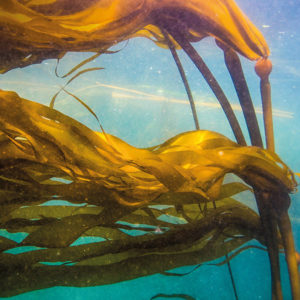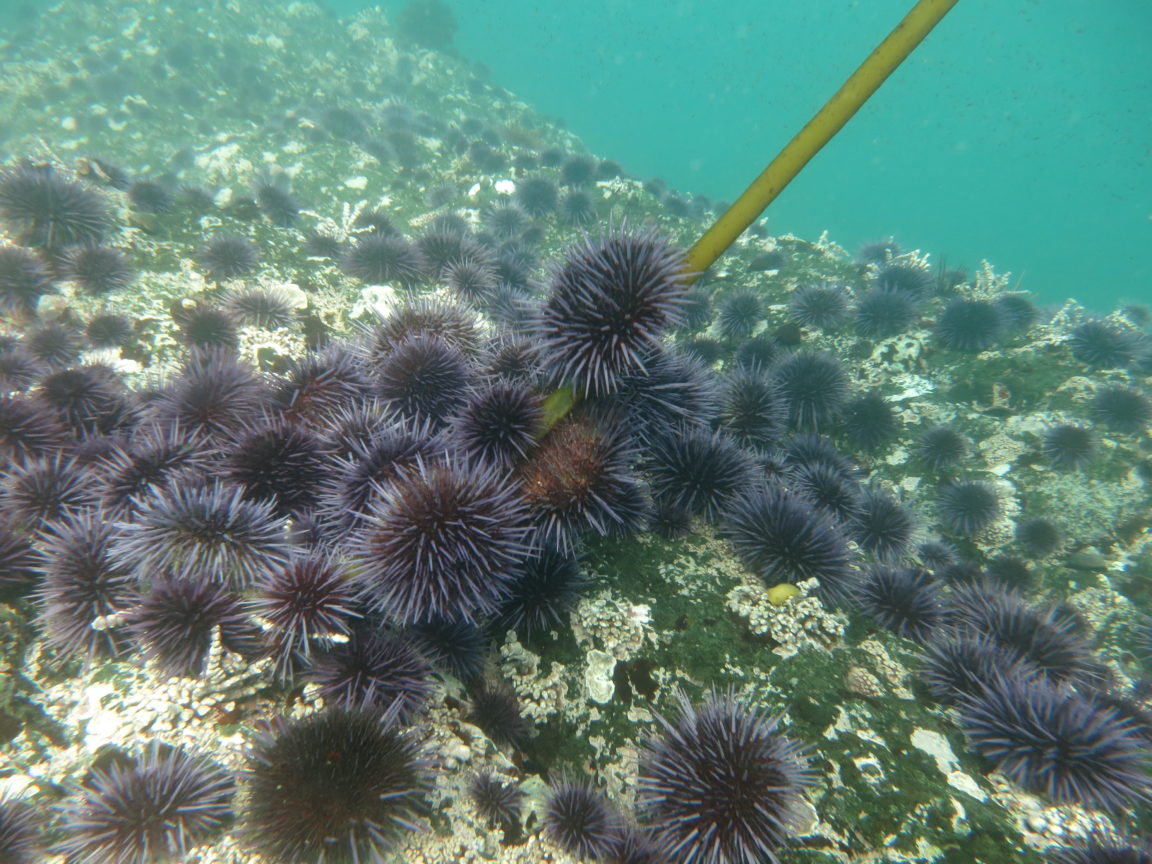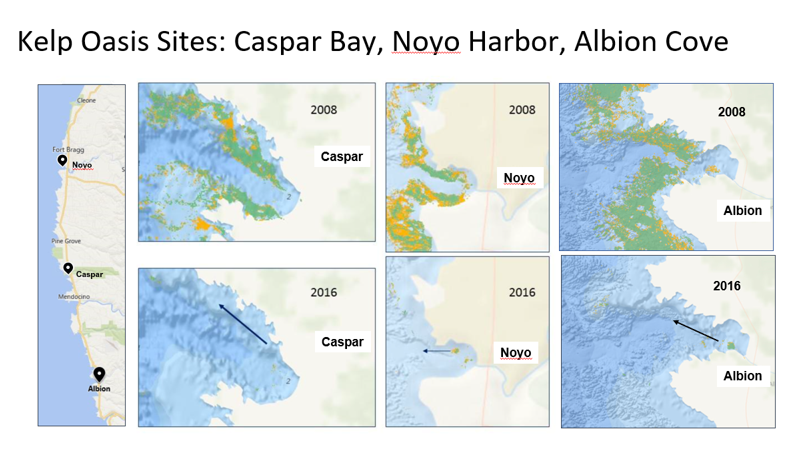How You Can Help
- Donate Today: From divers to scientists to farmers, this is a big project.
- Become a citizen scientist. Join our dockside sampling team (16 and over)
- Report sunflower sea stars if you see them! They are a good urchin predator
- Become informed and spread the word
- Help create a market for purple urchin

ECOSYSTEM IN CRISIS
Bull kelp forests are the foundation – or structure – of our nearshore coastal ecosystem. The floating canopy of this brown algae gives shelter to young fish and the kelp itself provides food for valuable species, such as red abalone and red sea urchin.

Today, our kelp forests are in serious trouble. Though annually variable, in the past five years, California’s kelp forests have decreased by 93% of normal. Higher sea surface temperatures in recent years have limited kelp growth, and sea star wasting disease has removed a key predator of purple sea urchins, a veracious eater of kelp. Though our waters have cooled this past year, the explosion of the purple urchin population—60 times higher than normal—and has prevented the kelp forests from recovering from these multiple blows.
The effects of the kelp forest loss reach from the ocean to the shore. The red abalone fishery, severely impacted by a lack of food, has been closed this year. Fewer fish has meant that shore birds do not have enough food for their chicks. This year, 90% of the local cormorant and 80% of the black oystercatcher nestlings failed to survive. Fewer young fish also means fewer larger fish for marine mammals, such as harbor seals and sea lions.

In the nearshore environments, urchin now out competing red abalone and other herbivores for kelp, creating what’s known as an urchin barren. This is what we are seeing along most of our coastline today.
What’s Being Done to Address this Crisis?
A highly collaborative team has formed on the north coast to begin clearing purple urchin from an area, creating essentially a kelp “refuge” area. The goals of this program are:
- Support the natural recovery of bull kelp along the Mendocino and Sonoma coasts by creating kelp refuge areas. As an annual species, bull kelp needs to release spores to produce next year’s forests. By significantly reducing density of purple urchin in refuge areas, kelp will have a chance to recruit, grow to full size and reproduce.
- Support the development of a commercial market for purple urchin. Red urchin are the commercial urchin that provide uni to your favorite sushi restaurant. Purple urchin are much smaller, and essentially starving. Over the past two years, our program has investigated ways to create products for the purple urchin, such as a calcium source for fertilizer or compost. In 2019, in collaboration with our partners at Urchinomics and The Nature Conservancy, aquaculture trials are underway at Bodega Marine Lab to turn empty, worthless urchin removed from our barrens into a new highly valued seafood product. By feeding the urchin a formulated feed created from off-cuts of Japanese kombu seaweed production, commercially viable uni develops within 8 weeks. Using technology they have employed around the world, the potential to create restorative seafood product that rebuilds kelp beds and creates jobs is now a reality. More info.
- Monitor the dynamics between kelp and urchin. We certainly need to know more about the ongoing interaction between these species. Excessive urchin grazing has created >65% bare rock in highest urchin density areas. How fast will kelp recover once urchin are removed. How quickly will urchin reinvade a refuge area? How long can kelp spores remain viable in urchin barrens? Higher ocean temperatures and more acidic waters are changing the way these two species interact with each other.
- Engage community partners, students and citizen scientists. We live in a coastal environment reliant on our local ocean resources, whether for our job, our dinner, our vacation, or our enjoyment. To turn this crisis around, we will need the support of everyone, whether as a dockside sampler of purple urchin coming in, as a donor of our effort, more eyes in the water, or as a partner organization that can fill an important role. Contact us at info@nc.mymcn.org to inquire about becoming involved.
- Create research priorities for the larger ecosystem issues. Scientists will be working hard to identify the research needed to facilitate broad scale recovery and increase the resilience of bull kelp forest ecosystems in the face of increasing climatic and ecological stressors. Here is the latest funded research.
Bull Kelp Recovery Plan (HERE)
In order to understand and proactively respond to the drastic loss of bull kelp, the Greater Farallones National Marine Sanctuary Advisory Council convened the Kelp Recovery Working Group, chaired by the Greater Farallones Association, and the California Department of Fish and Wildlife to develop strategies for active kelp recovery, restoration site selection, monitoring and research, and community engagement.
Kelp Oasis Zones: North Caspar Bay, Noyo Harbor, and Albion Cove:
By looking at where we have had persistent kelp beds historically and have protection from the swell, the team selected three sites that to create kelp oasis zones– concentrating on removing purple urchin. Over the past 2 year, the Noyo Center coordinated the conservation effort in collaboration with CDFW, and the commercial divers removed over 2 million urchin these oasis zones, and we are actively monitoring for signs of recovery. Albion proved to be logistically challenging and was abandoned in 2019. This year, the conservation effort will be led by ReefCheck CA.

Recreational Diver Involvement
The California Fish and Game Commission approved emergency regulations for recreational take of purple sea urchins Off Mendocino and Somona Counties, increasing the daily bag limit from 35 individuals to twenty (20) gallons (that’s four 5-gallon buckets full). Further, last year the Commission approved a temporary trial in Caspar Bay that will allow recreational divers to crush urchin. If you are interested in participating in this effort at Caspar, contact our recreational dive partners at the Watermen’s Alliance, Josh Russo for more information (joshandleslie2@sbcglobal.net or (707)333-9575). It is important to note that crushing is NOT allowed anywhere outside of Caspar Bay.
Crushing v. Culling
Our conservation effort has focused so far on working with commercial urchin divers to clear out purple urchin from our oasis zones by either hand-picking or with an airlift machine. Because our fall ecosystem surveys continue to show urchin are reproductively viable even in these starvation conditions, scientists fear that crushing urchin will artificially spawn them and actually make the problem worse. Crushing trials are underway through ReefCheck, and will only be pursued when there is very low gonad present in the urchins, limiting the risk of spawning. Our team is appealing to Fish and Game Commission to create “free urchin days” (remove the daily bag limit) allowing recreational divers and local citizen scientists to contribute to the effort by smashing or removing urchin in the nearshore through a coordinated effort.
Bull Kelp Monitoring
Subtidal transect surveys will be conducted by CDFW and ReefCheck within the refuge areas to compare with surveys within the existing kelp patch. These surveys will be conducted within August and September to allow comparisons with previous year. Young bull kelp surveys will be conducted in spring (April – June) to assess the early growth of bull kelp inside and outside of the existing kelp patch and the refuge area. The Noyo Center for Marine Science will deploy mini-ROV and 360-degree camera with local volunteers and interns to document young bull kelp growth and reinvasion of purple urchin. Adult bull kelp aerial surveys will be conducted in October to determine the spatial extent of surface kelp in the project zones.
Our Partners grows weekly, and includes:
We Need YOU!

How can you make a difference?
- DONATE to this important effort. Your contribution supports:
- Divers collecting urchin
- Scientific monitoring of refuge sites
- Public outreach and education
- Classroom education
- Urchin reuse pilot project
- Get involved. Volunteer with the Noyo Center or any of the project partners.
- Join us as a commercial diver, a recreational diver or a citizen scientist reporting growing bull kelp.
- Come up with a great idea about how to use purple urchin so we can create a commercial market for this species. This will put divers back to work and help our local economy.
- Spread the word about this important project. Losing these kelp forests forever would be catastrophic to our way of life.
- Support climate change legislation and reform. The ocean absorb over 90% of the fossil fuels released into the atmosphere and the increase in temperature and acidity is creating these impacts all over the world. Clean energy today.
